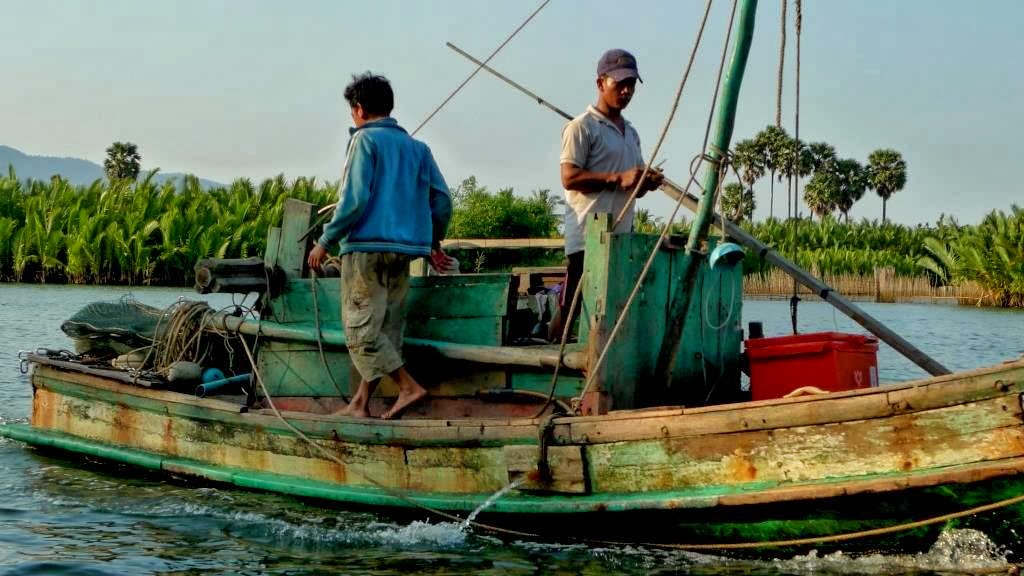23. Kampot Scenes
Sea salt, fishing boats and relaxed rural beauty
One evening I hired a boat for a sunset cruise up the river. One passes by the bamboo huts of the guesthouses, sometimes build into the river on stilts, and lots of untouched banana trees and coconut forest. These guesthouses along the river all advertise that they have a "pool", meaning people can swim in the river. Although the water looks OK on superficial inspection, and no industrial settlement upstream do exists, I am typically careful with things like that. I rather stay in the boat. Swimming in the river in town is not recommended because of underwater obstructions.
 |
| Guesthouses upstream from Kampot |
 |
| Fishermen going towards the coast |
At around 5 p.m. many small fishing boats travel down south to the mouth of the Preaek Tuek Chhu river and the Gulf of Thailand to spend the night on sea. These small ones are typically manned with two people, one who takes care of the nets, the other the captain, machinist and navigator.
 |
| The railroad bridge |
 |
| Sweet doggy at my guesthouse, one of five. They play all day in the sand of the little private beach. What a tough life. |
In town one can also see some larger fishing vessels. They are manned with 5 to 8 people, and have a large engine. After the ice and the fuel is loaded they are heading out. They leave much earlier in the day than the smaller boats I saw on the river, meaning they must travel farther out to sea.
The little sleepy town has four bridges: The old iron bridge, the new concrete bridge, the railway bridge and this one below, which connects the mainland to Fish Island, the location of Kampot sea salt production.
 |
| Colorful Wat on Fish Island. |
 |
| Sea salt drying pans. One can see the "Fleur de Sel" on the left edge of the photograph. The mountains in the back are already deep into Vietnam. |
 |
| Fleur de Sel. |
 |
| Salt pan and barn. |
The sea salt here is coarse and wet. It is a straight forward process of hand-scarping and collecting the dried salt from the basin ("pan"). The salt is stored in long wooden barns. The entire southern half of Fish Island is covered with the salt farms.
 |
| Farmer in his lotus pond. |
 |
| Sea salt from Kampot |
 |
| The roads around here are unpaved. |
 |
| Salt storage barns. |
Images below: Water buffaloes cross the road often all across the country. They are gentle, big creatures with a nice face, the proud possession of the farmers. They move rather slow, but one cannot be completely sure. Sometimes they seem to be in a hurry and start running unexpectedly - towards the other side, or towards you. Since this is a massive animal, the less massive motorcyclists has to give them the right of way.
Below is a young calf. It was noisy, seemingly complaining about something, a sound I haven't heard before. I waited until I was sure that it wouldn't start to run across.
 |
| This is how it is done: A few 2x4's under the rear seats of the mini-bus, a few ropes and the journey can begin. |
 |
| This is my plant: The "Traveler's Palm", actually not a palm tree exactly, but in the family of the Bird of Paradise plants. |
The last airplane flying into Kampot, a C-47, the military version of a common Douglas DC-3 of Cambodia Air Commercial was shot down on approach by the Khmer Rouge in October 1972. The aircraft was operating a passenger flight, all nine people on board were killed. Since then, the old runway is left to its own devices, the brush slowly engulfs the facility. I was told that at night on weekends it is used as a drag strip for the souped-up scooters of the younger population.
 |
| Old runway at Kampot airport |
 |
| Restored row of colonial shophouses, now B&B "The Columns". |
 |
| Kampot bus station. |
 |
| The French engineers and their fascination with cast-in-place concrete structures. |
 |
| Communal sport stadium Kampot. |
Very close to Kampot on the road to Bokor Hill Station and Sihanoukville one passes by a brand-new, clean and appealing hospital compound. There are few health centers in and around town, and the referral hospital in Kampot, but the place to go for emergency and other care is the "Sonja Kill Memorial Hospital". There are no other facilities of that kind which provide international-standard medical care such as this clinic. Especially in light of the child mortality rate in Cambodia (about 10 of 100 children don't reach the age of 9 years.) Because of the difficult medical infrastructure in this part of the world it is also good if one doesn't have an accident in this area, on motorcycles, or otherwise.
 |
| Sonja Kill memorial Hospital Kampot |
The hospital is named after the daughter of a husband and wife physician team from Germany, who died at an early age in a traffic accident. Dr. and Mrs. Kill's hospital foundation started with an initial, privately funded budget provided by the Kill family of 16 million Euros, yet more funds are needed especially to enlarge pediatric care.
The hospital is managed by Hope Worldwide, a medical charity out of Philadelphia. I will visit the hospital when I return in December.








































No comments:
Post a Comment